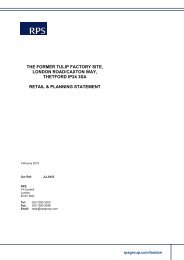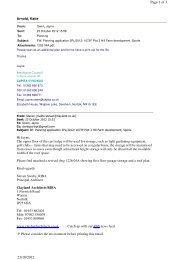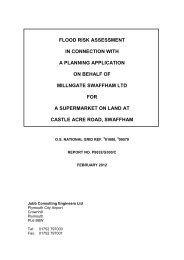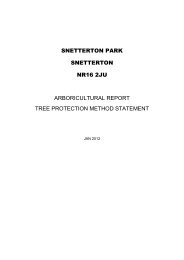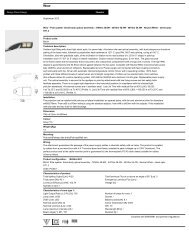Design and Access Statement Site: Lyng Farm, NR20 4JE
NR20%204JE%20Design%20and%20Access%20Statement.pdf
NR20%204JE%20Design%20and%20Access%20Statement.pdf
Create successful ePaper yourself
Turn your PDF publications into a flip-book with our unique Google optimized e-Paper software.
<strong>Design</strong> <strong>and</strong> <strong>Access</strong> <strong>Statement</strong><br />
<strong>Site</strong>: <strong>Lyng</strong> <strong>Farm</strong>, <strong>NR20</strong> <strong>4JE</strong><br />
Appendix B - Noise Report: Evance R9000<br />
Acoustic Impact Assessment of Small Wind System Installation<br />
In considering the noise generation of small wind systems <strong>and</strong> the impact of this noise level on<br />
neighbouring properties, Windcrop has been working with local Environmental Health Officers<br />
to develop a practicable <strong>and</strong> clear method of presenting the expected impact. This makes use<br />
of the ETSU-R-97 assessment approach which takes into account not only the noise levels at<br />
noise sensitive locations but also sets these against the expected background noise levels for<br />
the normally experience range of site wind speeds.<br />
Under the ETSU-R-97 methodology, the site background noise is measured against wind speed<br />
<strong>and</strong> this is then compared against the expected noise immission from the wind system(s). To<br />
undertake this type of testing for a small system is completely uneconomic <strong>and</strong> as such the<br />
approach being developed is that tests are being carried out on a range of typical site types to<br />
generate a reliable empirical generic forecast of background noise for a range of site types.<br />
Whilst this work is in progress, <strong>and</strong> to enable safe assessment to be made of the impact of<br />
small wind systems on noise today, a low level assumed background noise curve has been<br />
agreed as shown on the attached graph. This is based on data taken on open, treeless sites <strong>and</strong><br />
so represents a lowest expected background noise. It is also based on a base level of<br />
background noise with no wind of only 28dB. It is therefore expected that any typical rural site<br />
will have actual background above this level.<br />
The noise immission from the wind system(s) is then overlaid onto this background noise curve<br />
to enable an assessment to be made of the wind system noise compared with the background<br />
noise across the wind speed range. This shows that a worst case at a wind speed of around<br />
7.5m/s wind speed. A decision is then needed on the relative level of the wind system to<br />
background. To date the approach has focussed on the nigh time levels at the façade of a<br />
neighbouring property <strong>and</strong> set the limit as 3dB above background. A secondary level has also<br />
been reviewed based on amenity use of a garden taking 5dB above background at the<br />
boundary of a neighbouring garden. At present only the façade level is being assessed on the<br />
basis that the typical boundary immission at the worst case of 7.5m/s wind speed is under<br />
40dB <strong>and</strong> is considered well inside acceptable daytime amenity levels.<br />
Page | 13





